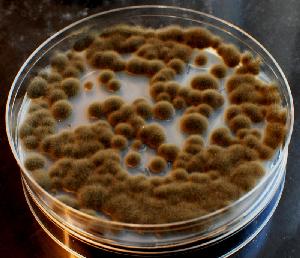
The fungus Zasmidium cellare is known as the wine cellar mold because it grows best when exposed to alcohol vapor in places that are cool and damp. This fungus is encountered most often on the walls of wine cellars and other areas where wine, brandy or other spirits are stored in wooden barrels or casks for aging. Alcohol vapor escaping from the barrels – the “angel’s share” – appears to stimulate growth of the fungus, which grows in thick mats of brown mycelium that can coat the walls. Because growth of the fungus is believed to improve air quality in the cellars its proliferation is encouraged. For example, wineries in the Tokay region of Hungary and parts of Germany are known for having vigorous growth of Z. cellare on the walls of their cellars. Some vintners even encourage this growth by feeding the fungus with leftover wine.
The wine cellar fungus has been known for many years. It was first named Racodium cellare in 1794 and records of its occurrence in wine cellars date to at least 1696. Since then its name has been changed to Cladosporium cellare and Rhinocladiella ellisii before settling on Zasmidium cellare. Phylogenetically, Z. cellare is in the fungal class Dothideomycetes, order Capnodiales, family Mycosphaerellaceae. This family contains many economically important pathogens of agricultural crops. The genome sequence of Z. cellare will be very important for comparisons with those of closely related plant pathogens to understand the genetic differences involved in saprobic versus pathogenic modes of nutrition.
Even though it has been known to science for longer than most other fungi, very little is known about the biology of Z. cellare. So far it has no known sexual stage so is thought to reproduce exclusively through asexual spores. Work done in Germany during the 1930s through 1950s showed that the fungus was able to metabolize a variety of volatile carbon sources in addition to ethanol. Metabolism of these volatile substances, including some that can be harmful to human health such as formaldehyde, is thought to be how the fungus apparently is able to purify the air, by removal of potentially toxic and malodorous vapors. Analyses of its genome sequence may identify the enzymes involved in this process, and potentially many other genes that can explain its highly unusual lifestyle.
Genome Reference(s)
Haridas S, Albert R, Binder M, Bloem J, LaButti K, Salamov A, Andreopoulos B, Baker SE, Barry K, Bills G, Bluhm BH, Cannon C, Castanera R, Culley DE, Daum C, Ezra D, González JB, Henrissat B, Kuo A, Liang C, Lipzen A, Lutzoni F, Magnuson J, Mondo SJ, Nolan M, Ohm RA, Pangilinan J, Park HJ, Ramírez L, Alfaro M, Sun H, Tritt A, Yoshinaga Y, Zwiers LH, Turgeon BG, Goodwin SB, Spatafora JW, Crous PW, Grigoriev IV
101 Dothideomycetes genomes: A test case for predicting lifestyles and emergence of pathogens.
Stud Mycol. 2020 Jun;96():141-153. doi: 10.1016/j.simyco.2020.01.003
